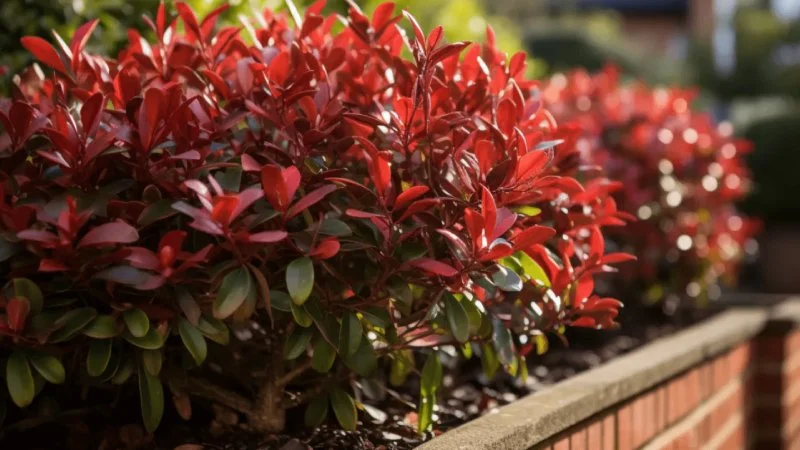Want to turn your Red Robin shrub into a full, bushy centerpiece or attract more how to Thicken Up a Red Robin birds to your garden? With a few targeted techniques, you can create a vibrant, healthy landscape filled with lush foliage and lively feathered visitors. Studies show that proper pruning and soil care can increase the density of Red Robin shrubs by up to 50%, while gardens with bird-friendly habitats see a 20-30% rise in Red Robin bird visits, especially in spring and fall.
In this article, we’ll walk you through effective steps to thicken up your Red Robin shrub and create an inviting space for Red Robin birds. From pruning and soil tips to creating the ideal habitat, we’ll cover everything you need to know to boost your garden’s beauty and make it a welcoming spot for these bright, resilient creatures.
Understanding the Red Robin Plant
The Red Robin (Photinia x fraseri) is an evergreen shrub known for its vibrant red, new growth. These plants are widely cherished for their aesthetic appeal and resilience, making them ideal for hedges, borders, and standalone accent plants. However, they can sometimes grow thin or leggy without proper care, which reduces their fullness and vibrant appearance. To understand how to thicken up a Red Robin, it’s essential to consider various aspects such as pruning, soil health, watering, and sunlight.
1. Pruning Techniques to Thicken Up a Red Robin
Pruning is one of the most effective ways to thicken up a Red Robin shrub. This encourages the growth of new shoots, resulting in a fuller and more robust appearance. Here’s how you can do it:
- Timing: The best time to prune your Red Robin is in early spring before new growth starts or late winter when the plant is dormant. Avoid pruning too late in the growing season, as this can expose new shoots to frost damage.
- Frequency: Regular pruning throughout the growing season (spring to summer) promotes bushiness. Each time you prune, you stimulate the plant to grow more branches.
- Technique: Focus on cutting back long, leggy branches. Make clean cuts just above a leaf node (the point where leaves attach to the stem) to encourage new growth from that point. This technique helps prevent “bald spots” and ensures even growth.
- Tools: Use clean, sharp pruning shears to make precise cuts and prevent infection. Disinfect your tools after pruning to avoid spreading diseases.
Regular and strategic pruning can help thicken up a Red Robin over time, producing a dense, well-shaped shrub with vibrant color.
2. Choosing the Right Soil
The soil in which a Red Robin is planted plays a critical role in its ability to grow thick and healthy. While Red Robin is adaptable, it thrives in soil with good drainage and balanced nutrients. Here’s how to optimize soil to thicken up a Red Robin:
- Soil Type: Red Robins prefer slightly acidic to neutral soil with good drainage. Heavy clay or overly sandy soil may hinder growth. If necessary, amend your soil with organic compost or well-rotted manure to improve its structure.
- Nutrients: Adding compost or a balanced fertilizer will provide the plant with essential nutrients. Look for fertilizers that contain nitrogen, phosphorus, and potassium, which promote healthy foliage and strong roots. Applying a slow-release fertilizer in early spring can help maintain steady growth throughout the season.
- Mulching: Applying a layer of mulch around the base of the plant helps retain moisture, suppress weeds, and slowly enriches the soil as it breaks down. Mulch also insulates the soil, protecting roots during extreme temperatures.
Healthy, nutrient-rich soil can make a significant difference when working on how to thicken up a Red Robin. It provides the plant with the strength needed to grow dense and vibrant foliage.
3. Watering Guidelines for Optimal Growth
Watering Red Robins is crucial for maintaining their health and encouraging a thick appearance. Here’s what you need to know:
- Consistency: Red Robin shrubs need a consistent watering routine, especially during dry spells. While they are drought-tolerant once established, they benefit from regular watering in their early years.
- Avoid Overwatering: Too much water can lead to root rot, which hinders the plant’s ability to absorb nutrients. Ensure that the soil is moist but not soggy, and avoid watering directly onto the leaves to prevent fungal growth.
- Deep Watering: Water deeply at the base of the plant rather than just sprinkling the surface. This encourages deeper root growth, helping the plant establish a strong foundation.
4. Ensuring Adequate Sunlight
Red Robins thrive in full sun to partial shade, and providing the right amount of light is key to helping your plant grow thick and full. Here’s how light affects growth:
- Full Sun: In regions with milder climates, full sun exposure encourages vibrant red foliage and dense growth. If possible, plant your Red Robin in a location where it receives at least 6 hours of sunlight daily.
- Partial Shade: In hot climates, partial shade during the hottest part of the day can protect the plant from stress and dehydration.
- Avoid Shaded Areas: Too much shade can lead to sparse growth as the plant stretches toward the light, which reduces its density.
5. Protecting Red Robin from Pests and Diseases
Like many plants, Red Robins can be affected by pests and diseases that may hinder their growth. Protecting your plant from these issues is crucial in learning how to thicken up a Red Robin.
- Common Pests: Aphids, scale insects, and spider mites can infest Red Robins. These pests suck nutrients from the leaves and stems, which weakens the plant. Regular inspection and using insecticidal soap or neem oil can help control these pests.
- Diseases: Red Robin shrubs are prone to leaf spot and powdery mildew, especially in humid conditions. These diseases can reduce the plant’s vigor and affect its ability to grow dense foliage. Remove affected leaves, improve air circulation, and consider using a fungicide if necessary.
Preventing pest and disease damage can significantly impact the fullness and health of your Red Robin, ensuring it grows thick and lush.
6. Seasonal Maintenance for Thicker Growth
Seasonal maintenance plays an important role in the overall health of Red Robins. Proper care during each season can set up your shrub for optimal growth.
- Spring: This is the best time to prune and fertilize, as the plant will enter its peak growth phase. Apply a slow-release fertilizer to boost growth and encourage thick foliage.
- Summer: Continue light pruning to maintain shape and inspect for pests. Water regularly, especially in dry weather, to keep the shrub hydrated.
- Fall: Reduce pruning as the plant begins to prepare for dormancy. Remove any dead or damaged branches.
- Winter: Add a fresh layer of mulch to insulate the roots. Avoid heavy pruning, but remove any snow or ice that accumulates on the branches to prevent breakage.
Conclusion
Achieving a full, bushy Red Robin takes time and consistent care. By following these tips on how to thicken up a Red Robin, you can enjoy a vibrant, dense shrub that enhances the beauty of your garden. From strategic pruning to regular watering and proper sunlight exposure, each step contributes to a healthier, thicker plant. With the right attention and techniques, your Red Robin can thrive and provide a stunning display of color and texture throughout the seasons.
Whether you’re growing a Red Robin hedge or a standalone plant, these methods will help you achieve the look you desire, making it a standout feature in your landscape. Start implementing these tips today, and watch your Red Robin transform into a thick, lush centerpiece in your garden!
For more informative articles, be sure to visit our site daily!

